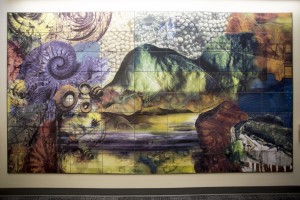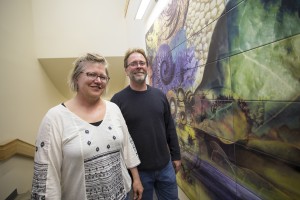An art-inspired homecoming
by Jamie Gonzales |

New art in the Natural Sciences Building, "Assemblage and Inquiry," by alumna Amy Baur and former UAA professor Brian Boldon. Ted Kincaid/University of Alaska Anchorage.
Well, the Natural Sciences Building just got more aesthetically pleasing. For that, you can thank an alumna artist and an interdisciplinary team of faculty and staff who were charged with selecting the artwork, "Assemblage and Inquiry," a tile landscape of layered natural sciences imagery.
Amy Baur and her husband Brian Boldon, Minnesota artists with Alaska roots, returned to UAA last month to oversee the installation of their ceramic piece in the recently remodeled Natural Sciences Building.
"We haven't been back to Alaska in 19 years. We kind of fell back in love with it," said Baur, an alumna who earned a B.F.A. in photography from UAA in 1994. Boldon oversaw the ceramics program at UAA from 1990-1995.
The two artists met in Fairbanks in 1982, where Boldon found work in construction and Baur worked as a gold miner. They never envisioned their careers would mesh and lead to creating public art installations around the U.S., as they've done for the last decade.
"We can't believe we can make it as artists. I mean, who gets to do that?" said a smiling Baur.
They've put their heads together to create everything from relatively small pieces like the 72-tile "Assemblage and Inquiry" to an 800-tile piece in St. Paul Union Depot in Minnesota. Check out their portfolio of glass and ceramic art installations at inplainsight art.
Their work, as Boldon puts it, "requires two brains"-one for the photography and digital design and another for the physical ceramics, glaze and kiln elements. They are the only artists in the U.S. currently making art using a process originally invented to make Wedgewood china patterns.
How do you get the picture onto the tiles?
Baur explained it like this: "We actually have a machine that prints glaze. In this old Canon laser printer, instead of there being toner in it, there's cyan, yellow, magenta and black pulverized glaze. There's gold in it-it's like a mini college education every time I fill it."
Like affixing a model airplane decal, said Boldon, the printer prints onto a piece of gummed paper using electrostatic energy to transfer metal pigments.
"At that point you could take your finger and wipe the powder off the paper, it's just barely on there. What we do is laminate over the top of it this super thin, really flexible layer called Cover Coat," he continued as Baur leaned away to whisper to me, "You can tell he was a professor."
It then gets soaked and overlaid onto the tile. "Like a temporary tattoo?" asked an onlooker.
Yep, close. But once the printed design is affixed to the tiles it gets fired in the kiln, burning away the laminate and gum residue and turning the pigment to glass.
"I thought it would be just a matter of time and you'd be able to buy a ceramic printer at Best Buy, but it's really, really fussy," said Boldon who began using the process in 2002. "The metals and glass are corrosive and gritty and the machine doesn't like it."

Amy Baur and Brian Boldon pose with their ceramic tile art installation in the Natural Sciences Building. Ted Kincaid/University of Alaska Anchorage
"Many people did try to do this and they've all quit," added Baur. Not the Baur-Boldon double-threat, though. Something Baur chalks up to their bulldog determination.
These are the kind of people who, after putting in a long day of work when they were first in Alaska, came home ready to put in another.
"We built a house together out of pocket in Fairbanks," said Baur. "Most young kids are drinking their paychecks away. We built a house. I learned how to do electrical, he learned how to do plumbing. He was a picture framer, so he knew how to do carpentry. Every night we'd come home and pop a Lucky beer. That was dinner. Then we'd go upstairs and start working."
Inspiration for "Assemblage and Inquiry"
"Using geologic sedimentation and landscape metaphorically, we assembled areas of scientific study taught in this building into an integrated visual experience," wrote Baur and Boldon in their concept statement about the piece. "Disciplines of geology, biology, astronomy and physics are references using imagery of fossils, DNA charts and star patterns woven together to create a vibrant and inviting experience as students traverse the stairwell."
For Baur, it's still about photography. Only now she doesn't need to worry about keeping things dust-free and airtight. Unlike most works of art, you can go ahead and touch this one. Because it's kiln-fired glaze on ceramic, it can be wiped down with industrial cleaners. Extra points for resilience!
"When you start to see your photographs building-size...it changed my life," she said.
"The fleeting electronic image now is good for 3,000 years," added Boldon. "The old world meets the new world."
Now, to figure out how to preserve the Natural Sciences Building for 3,000 years...we may need to convene another interdisciplinary committee.
This story written by Jamie Gonzales, UAA Office of University Advancement.
 "An art-inspired homecoming" is licensed under a Creative Commons Attribution-NonCommercial 4.0 International License.
"An art-inspired homecoming" is licensed under a Creative Commons Attribution-NonCommercial 4.0 International License.














